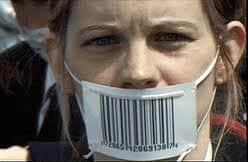Anatomy of a Contagion: The Debt Trap
The following explains two previous paradigm shifts:
“There was the first great depression, which lasted for 26 years during the 19th century. That event was named the “Long Depression”. After the 1930s crash, that depression became known as the “Great Depression.” Both involved a paradigm shift where the first followed the introduction of the railroads, which then displaced many jobs involving horses and carts. The next Great Depression saw the collapse in agriculture, which had employed 40% of the civil workforce at the turn of the 20th century. With the invention of the combustion engine and tractors, this reduced the need for manual labor. Then the Dust Bowl hit, driving unemployment to 25%. It took World War II to restore the economy by absorbing the excess agricultural labor and forcing them to become qualified.”
Martin Armstrong

On top of the current paradigm shift favoring e-commerce and home based work, there is a paradigm shift in the world global finances. For instance, the concentration of wealth held by transnational corporations is matched by high levels of debt held by governments, corporations and consumers. Corporate buybacks and the products and services that people purchase is bought on credit. Both buybacks and things consumers buy increase stock market valuations and results in a disproportionately high levels of debt shared by most.
High stock valuations have been kept alive by central banks and pension funds who don’t have a better place to invest their money except in equities as interest rates are close to zero percent. Pension funds need a rate of return of at least 6 to 8% in order to stay afloat and pay remittances and benefits to retirees.
This concentration of wealth and expansion of debt is at the core of a dynamic polarity between greed and fear. It is reflected in the anxiety that erupted during the repo crisis on September 2019 when the invisible hand of the market shook the confidence of financial institutions. Market players were demanding higher interest rates to match the increasing risk involved in equities’ high valuations stemming from low interest rates concurrent with high debt levels. An increase in interest rates would cause a monetary crisis and the economy to contract.
The US dollar is the reserve currency of the world as a result the Fed’s interest rates policy does not only effect the domestic economy but the world’s financial systems. Many foreign countries have borrowed in US dollars. This resulted in a debt trap as interest rates could not be raised in the US without destabilizing foreign monetary systems, especially the European banking system stuck with a negative interest rates policy.
To manage an eventual unraveling of a debt trap, governments and related institutions were compelled to prepare for an orderly transition to a new financial order. And also to deflect the responsibility for the consequences of low interest rates policies.
The current environment triggered a replay of the Y2K scare. This time, fear of a deadly virus was used instead. Corporate mass media and online sources of information, jumped on the occasion to exploit fear to increase ratings to generate advertising money. While governments used emergency orders at the beset of special interests to implement lockdowns and the suspension of individual rights that are typically used only in times of war.
Y2K was named after a programming glitch expected to cause a global application crash on 01/01/2000. The oversight was the result of programmers trying to save valuable memory space by setting the year with two digits as in 01/01/99 instead of four, 01/01/1999.
The scare started a few years prior the turn of the millennium when news that computer programs would not convert seamlessly into 01/01/2000. Fears of malfunction on planes and elevators and other essential applications began to spread. Reports of power grids and financial systems were predicted to crash dominated the headlines. Fear turned into full blown hysteria that peaked until the dreaded day.
Most of my relatives live in Italy. At the time I read Italian and French newspapers. I noticed the lack of concern about the threat posed by Y2K overseas. European country’s reaction was in stark contrast with the end of the world scenario that was publicized in the US. The main reason for their composure was that governments, institutions and businesses in Europe took a reasonable approach to the situation and hired programmers to do the tedious job of changing the codes/date to avoid a problem without the need to alert the public.
On 01/01/2000, a systemic crash did not occur. The world did not end. In the US, programmers were celebrated by the media has having saved the day. In retrospect, a debunked assessment the period reveals that the hysteria benefited media ratings and advertising revenues. It enriched shady programmers who made tons of money exploiting people’s fear of a systemic collapse.
But a crash did occur that year.
On March 10, 2000, the dotcom bubble burst. It was the result of unsustainable amounts of money that fueled the Nasdaq mania between 1995 and 2000. The index rose five-fold during that period, reaching a high of 5,048. A year and half later the index was down 77% form its high. Venture capitalists and speculators were willing to gamble their money that the Internet and Web start-ups would be the leading industries in the future and be very profitable investments.
It took twenty years for speculators to be right. The FANGs did crawl out of their grave and reassert themselves as a turbulent paradigm shift.
In times of crisis, there are always individuals and special interests ready to exploit the situation to their own advantage. A crisis is an opportune time to make tons of money and impose views on how the world should be run or who should run it.
Next: A Globalists’ Reset vs the Nation-State.


